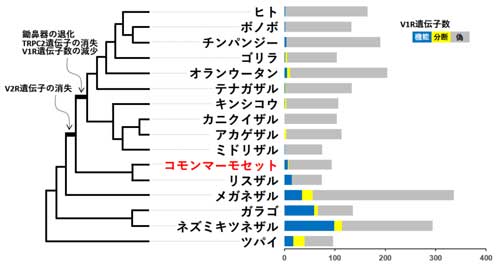



|
TOPICS BONOBO Chimpanzee "Ai" Crania photos Itani Jun'ichiro archives Open datasets for behavioral analysis Guidelines for Care and Use of Nonhuman Primates(pdf) Study material catalogue/database Guideline for field research of non-human primates 2019(pdf) Primate Genome DB 
Primate Research Institute, Kyoto University Copyright (c) |
Japanese Evolution of vomeronasal receptor 1 (V1R) genes in the common marmoset (Callithrix jacchus).
Keiko Moriya-Ito, Takashi Hayakawa, Hikoyu Suzuki, Kimiko, Hagino-Yamagishi, Masato Nikaido
Abstract
Pheromones are crucial for eliciting innate responses and inducing social and sexual behaviors in mammals. The vomeronasal receptor 1 genes, V1Rs, encode members of a pheromone receptor family that are mainly expressed in the vomeronasal organ (VNO). The V1R family shows extraordinary variety in gene number among vertebrates owing to successive gene gains and losses during evolution. Such diversity is believed to reflect a degree of dependence on the VNO. We investigated V1R evolution in primate lineages closely related to humans because these VNOs show a trend toward degeneration. We performed extensive phylogenetic analyses for V1Rs from a broad range of primate species. Although the decline of intact genes was evident in anthropoids (hominoids, Old World monkeys and New World monkeys), we found that a certain number of intact genes persist in New World monkeys. In one New World monkey species, the common marmoset (Callithrix jacchus), we examined seven putatively functional V1Rs using in situ hybridization and reverse transcription-PCR. Based on their mRNA expression patterns in the VNO and other organs, two types of V1Rs emerged: the canonical class with VNO-specific expression, and a second group having more ubiquitous expression in various organs as well as VNO. Furthermore, phylogenetic analysis revealed that the class with the more widespread expression had been retained longer in evolution than the VNO-specific type. We propose that the acquisition of a novel non-VNO-related function(s) may have led to the survival of a small but persistent number of V1Rs in anthropoid primates.  2017/12/07 Primate Research Institute
|